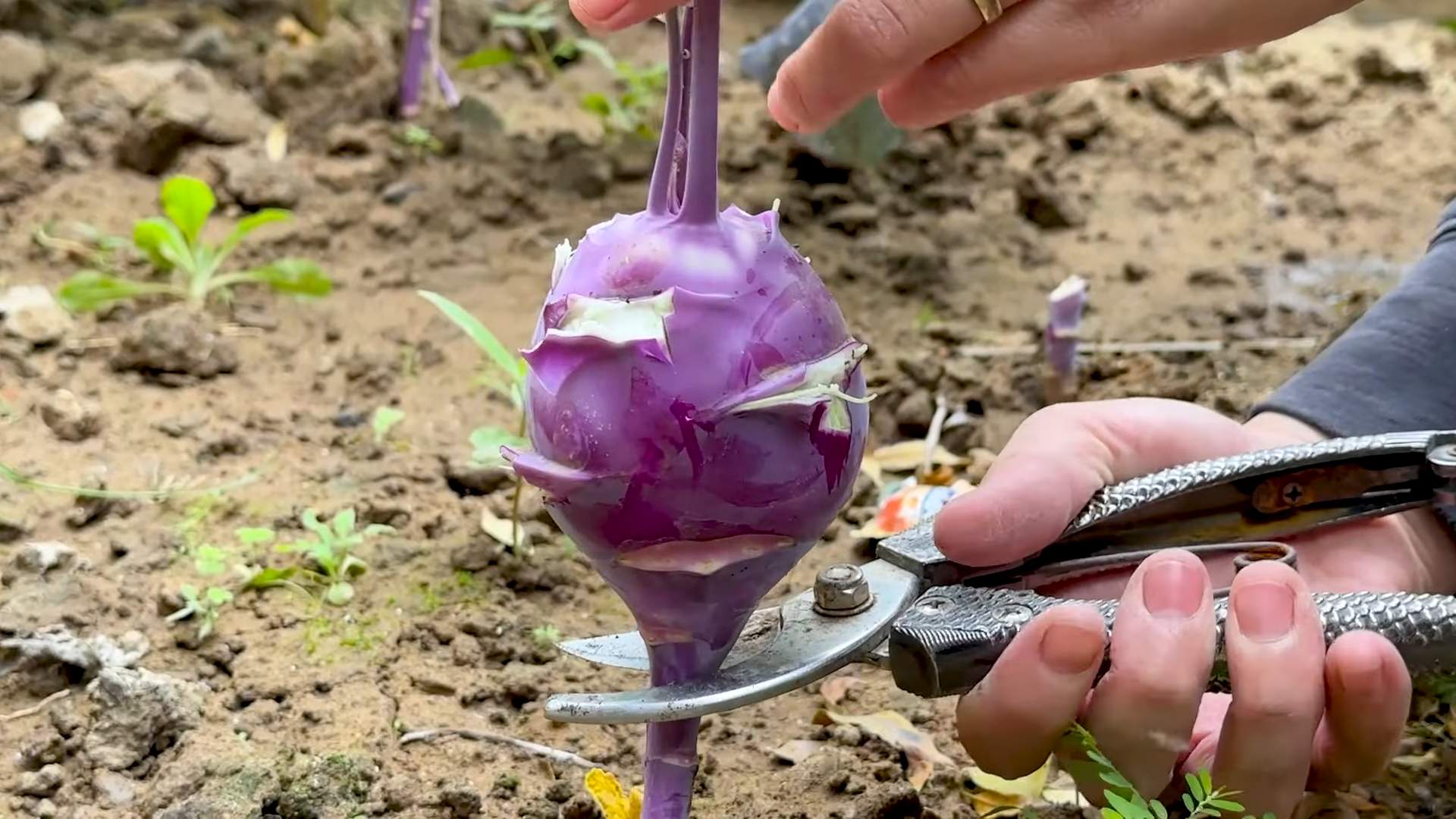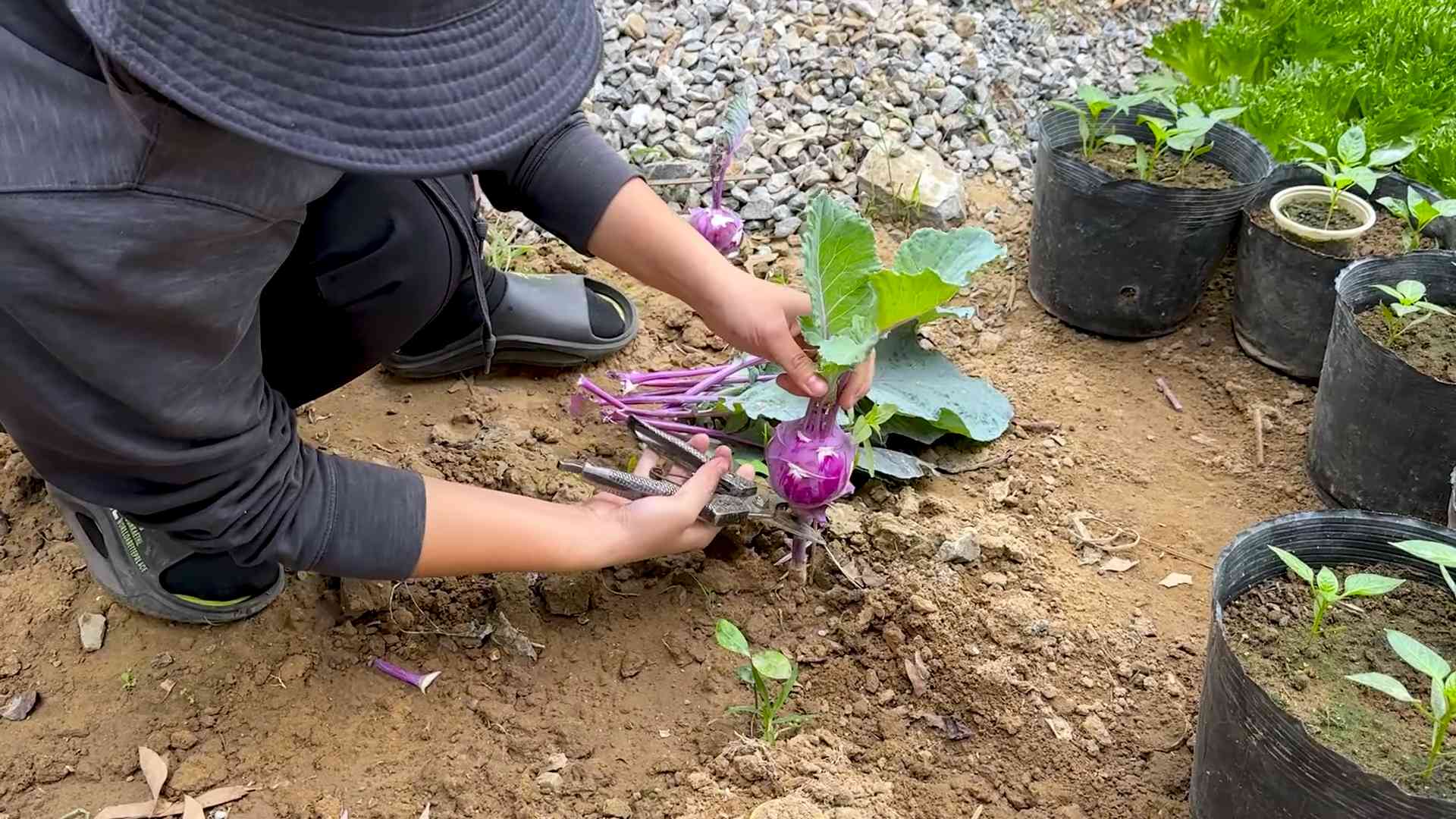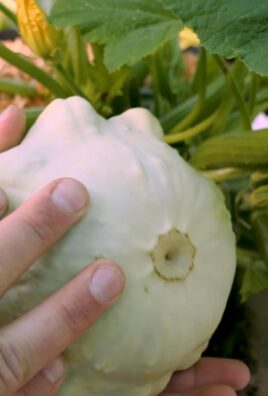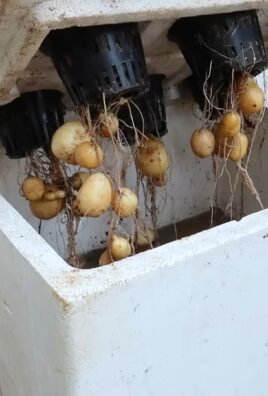Kohlrabi Growing Tips: Ever dreamt of strolling through your garden and harvesting a spaceship-shaped vegetable that tastes like a sweet, crunchy cross between a turnip and a cabbage? Well, dream no more! This often-overlooked veggie, with its quirky appearance, is surprisingly easy to grow at home, and I’m here to share all my secrets to a bountiful kohlrabi harvest.
Kohlrabi, whose name literally translates to “cabbage turnip” in German, has been enjoyed in Europe for centuries. It’s a staple in many cuisines, offering a unique flavor and texture that elevates everything from salads to stir-fries. But beyond its culinary appeal, growing your own kohlrabi is incredibly rewarding. Imagine the satisfaction of serving a dish featuring a vegetable you nurtured from seed to table!
Many gardeners shy away from kohlrabi, thinking it’s difficult to cultivate. But the truth is, with a few simple tricks and hacks, you can easily master kohlrabi growing tips and enjoy a steady supply of this nutritious and delicious vegetable. I’ll guide you through everything from choosing the right variety and preparing your soil to preventing common pests and knowing when to harvest. So, ditch the grocery store kohlrabi and get ready to embark on a fun and fulfilling gardening adventure! Let’s unlock the secrets to growing perfect kohlrabi in your own backyard.

Kohlrabi Growing: From Seed to Supper – My Foolproof Guide!
Okay, so you want to grow kohlrabi? Awesome! It’s a seriously underrated vegetable, and honestly, it’s way easier to grow than you might think. I’ve had some amazing success with it in my garden, and I’m going to share all my secrets with you. Get ready for some delicious, crunchy kohlrabi!
Choosing Your Kohlrabi Variety
First things first, let’s talk about varieties. There are a few different types of kohlrabi, and they come in different colors and sizes. Here are a few of my favorites:
* Early White Vienna: This is a classic, reliable variety that matures quickly. It’s perfect if you’re impatient like me and want to harvest your kohlrabi sooner rather than later.
* Early Purple Vienna: Similar to the white variety, but with a beautiful purple skin. The flesh is still white and tastes the same. It just adds a little visual interest to your garden (and your plate!).
* Grand Duke: This is a larger variety that’s known for its excellent flavor and resistance to bolting (going to seed prematurely).
* Kossak: If you want HUGE kohlrabi, this is the one for you. It can grow to be the size of a softball without getting woody or tough.
When to Plant Kohlrabi
Timing is key when it comes to kohlrabi. It’s a cool-season crop, which means it thrives in cooler temperatures.
* Spring Planting: Start seeds indoors 4-6 weeks before the last expected frost. You can also direct sow seeds in the garden 2-3 weeks before the last frost.
* Fall Planting: For a fall harvest, sow seeds directly in the garden 6-8 weeks before the first expected frost.
Preparing the Soil
Kohlrabi needs well-drained, fertile soil to thrive. Here’s how I prepare my soil:
* Choose a Sunny Spot: Kohlrabi needs at least 6 hours of sunlight per day.
* Amend the Soil: Work in plenty of compost or well-rotted manure to improve drainage and fertility. Kohlrabi loves rich soil!
* Check the pH: Kohlrabi prefers a soil pH of 6.0 to 7.5. You can test your soil with a soil testing kit and amend it accordingly.
Starting Seeds Indoors (Optional)
If you’re starting seeds indoors, here’s what you need to do:
1. Gather Your Supplies: You’ll need seed starting trays or pots, seed starting mix, kohlrabi seeds, and a spray bottle.
2. Sow the Seeds: Fill the trays or pots with seed starting mix and moisten it. Sow the seeds about 1/4 inch deep.
3. Provide Light and Warmth: Place the trays or pots in a warm location (around 70-75°F) and provide plenty of light. A grow light works great, or you can use a sunny windowsill.
4. Keep the Soil Moist: Water the seedlings regularly, keeping the soil moist but not soggy.
5. Harden Off the Seedlings: Before transplanting the seedlings outdoors, you’ll need to harden them off. This means gradually exposing them to outdoor conditions over a period of 7-10 days. Start by placing them outside for a few hours each day, gradually increasing the amount of time they spend outdoors.
Direct Sowing Kohlrabi Seeds
If you’re direct sowing seeds in the garden, here’s what you need to do:
1. Prepare the Soil: Make sure the soil is well-drained and fertile.
2. Sow the Seeds: Sow the seeds about 1/4 inch deep and 1-2 inches apart.
3. Water the Seeds: Water the seeds gently, keeping the soil moist.
4. Thin the Seedlings: Once the seedlings emerge, thin them to 4-6 inches apart. This will give them enough room to grow.
Transplanting Kohlrabi Seedlings
If you started your seeds indoors, here’s how to transplant them into the garden:
1. Prepare the Planting Area: Dig holes that are slightly larger than the root balls of the seedlings. Space the holes 4-6 inches apart.
2. Remove the Seedlings from the Trays or Pots: Gently remove the seedlings from the trays or pots, being careful not to damage the roots.
3. Plant the Seedlings: Place the seedlings in the holes and backfill with soil.
4. Water the Seedlings: Water the seedlings thoroughly.
Caring for Your Kohlrabi Plants
Once your kohlrabi plants are in the ground, here’s how to care for them:
* Water Regularly: Kohlrabi needs consistent moisture to thrive. Water deeply whenever the soil feels dry to the touch.
* Fertilize: Fertilize your kohlrabi plants every 2-3 weeks with a balanced fertilizer.
* Weed Regularly: Keep the area around your kohlrabi plants free of weeds. Weeds can compete with your kohlrabi for nutrients and water.
* Mulch: Apply a layer of mulch around your kohlrabi plants to help retain moisture and suppress weeds. Straw, wood chips, or shredded leaves work well.
Dealing with Pests and Diseases
Kohlrabi is generally a pretty easy crop to grow, but it can be susceptible to a few pests and diseases. Here are some common problems and how to deal with them:
* Cabbage Worms: These little green caterpillars can munch on the leaves of your kohlrabi plants. You can control them by handpicking them off the plants or by using an organic insecticide like Bacillus thuringiensis (Bt).
* Flea Beetles: These tiny beetles can create small holes in the leaves of your kohlrabi plants. You can control them by covering your plants with row covers or by using an organic insecticide like pyrethrin.
* Clubroot: This fungal disease can cause the roots of your kohlrabi plants to become swollen and distorted. To prevent clubroot, make sure to plant your kohlrabi in well-drained soil and avoid planting it in the same location year after year.
Harvesting Your Kohlrabi
The best part! You can harvest your kohlrabi when the bulb is about 2-3 inches in diameter. Don’t let it get too big, or it will become tough and woody.
1. Loosen the Soil: Gently loosen the soil around the base of the plant.
2. Pull the Plant: Pull the plant out of the ground.
3. Cut Off the Leaves: Cut off the leaves, leaving about an inch of stem attached to the bulb.
Storing Your Kohlrabi
Kohlrabi can be stored in the refrigerator for several weeks. Just wrap it in a plastic bag or store it in a container. You can also freeze kohlrabi. To freeze it, blanch it in boiling water for 2-3 minutes, then cool it in ice water. Drain the kohlrabi and store it in freezer bags.
Enjoying Your Kohlrabi
Now for the fun part – eating your kohlrabi! There are so many ways to enjoy it. Here are a few of my favorites:
* Raw: Kohlrabi is delicious raw. Just peel it and slice it into sticks or cubes. It’s great in salads or as a snack with dip.
* Roasted: Roasting kohlrabi brings out its sweetness. Just toss it with olive oil, salt, and pepper and roast it in the oven at 400°F for 20-25 minutes.
* Steamed: Steamed kohlrabi is a healthy and delicious side dish. Just steam it until it’s tender-crisp.
* Mashed: Mashed kohlrabi is a great alternative to mashed potatoes. Just boil or steam the kohlrabi until it’s tender, then mash it with butter, milk, and salt.
* In Soups and Stews: Kohlrabi adds a unique flavor and texture to soups and stews. Just chop it up and add it to your favorite recipe.
Troubleshooting Common Kohlrabi Problems
Even with the best planning, sometimes things go wrong. Here are a few common kohlrabi problems and how to fix them:
* Kohlrabi Bulbs are Small: This could be due to a number of factors, including poor soil, lack of water, or overcrowding. Make sure your soil is fertile, water your plants regularly, and thin them to the proper spacing.
* Kohlrabi Bulbs are Tough and Woody:

Conclusion
So, there you have it! Mastering the art of growing kohlrabi doesn’t require a green thumb blessed by the gardening gods. It’s about understanding its needs, providing the right environment, and employing a few clever DIY tricks to maximize your yield and minimize potential problems. We’ve explored everything from seed starting to pest control, all with the aim of helping you cultivate plump, delicious kohlrabi bulbs right in your own backyard.
Why is this DIY approach a must-try? Because it empowers you to take control of your garden and your food. You’re not just passively planting seeds; you’re actively creating the ideal conditions for kohlrabi to thrive. This means healthier plants, fewer chemical interventions, and ultimately, a more rewarding gardening experience. Plus, there’s nothing quite like the satisfaction of harvesting a vegetable you’ve nurtured from seed to table.
But don’t stop there! Experiment with different varieties of kohlrabi. Try the ‘Early White Vienna’ for its mild flavor or the ‘Purple Vienna’ for its striking color and slightly more robust taste. Consider companion planting. Marigolds can deter pests, while dill attracts beneficial insects. You can even try succession planting, sowing seeds every few weeks to ensure a continuous harvest throughout the growing season.
And remember, growing kohlrabi is a journey, not a destination. There will be successes and setbacks, but each experience is a learning opportunity. Don’t be afraid to adapt our tips to your specific climate and soil conditions. Observe your plants closely, listen to their needs, and adjust your approach accordingly.
The key takeaway is that successful kohlrabi cultivation hinges on proactive care and a willingness to experiment. By implementing these DIY strategies, you’ll be well on your way to enjoying a bountiful harvest of this unique and versatile vegetable.
We’re confident that with a little effort and these helpful hints, you’ll be enjoying homegrown kohlrabi in no time. So, grab your seeds, get your hands dirty, and prepare to be amazed by the results.
We encourage you to try these DIY kohlrabi growing tips and share your experiences with us! Let us know what worked for you, what challenges you faced, and any other tips you’ve discovered along the way. Your insights can help other gardeners succeed and contribute to a thriving community of kohlrabi enthusiasts. Share your photos, stories, and questions in the comments section below. Happy gardening!
Frequently Asked Questions (FAQ)
What is the best time to plant kohlrabi?
The timing of planting kohlrabi depends largely on your climate. Kohlrabi thrives in cool weather, so the best time to plant is either in early spring or late summer for a fall harvest. For spring planting, start seeds indoors 4-6 weeks before the last expected frost. Transplant seedlings outdoors once the soil has warmed slightly and the risk of frost has passed. For a fall harvest, sow seeds directly into the garden in late summer, about 6-8 weeks before the first expected frost. In warmer climates, you can often grow kohlrabi throughout the winter.
How much sunlight does kohlrabi need?
Kohlrabi requires at least 6 hours of direct sunlight per day to thrive. While it can tolerate partial shade, especially in hotter climates, insufficient sunlight will result in leggy growth and smaller bulbs. Choose a planting location that receives ample sunlight throughout the day. If you’re growing kohlrabi indoors, use grow lights to supplement natural sunlight.
What kind of soil is best for growing kohlrabi?
Kohlrabi prefers well-drained, fertile soil with a pH between 6.0 and 7.5. Amend heavy clay soil with compost or other organic matter to improve drainage and aeration. Sandy soil can be improved by adding compost to help retain moisture and nutrients. Before planting, incorporate a balanced fertilizer into the soil to provide essential nutrients for healthy growth. Regular soil testing can help you determine if your soil is lacking any specific nutrients.
How often should I water kohlrabi?
Kohlrabi needs consistent moisture to produce plump, juicy bulbs. Water deeply and regularly, especially during dry periods. Aim to keep the soil consistently moist but not waterlogged. Mulching around the plants can help retain moisture and suppress weeds. Avoid overhead watering, as this can increase the risk of fungal diseases. Use a soaker hose or drip irrigation to deliver water directly to the roots.
What are some common pests and diseases that affect kohlrabi?
Kohlrabi is susceptible to several common garden pests, including cabbage worms, aphids, flea beetles, and cabbage root maggots. Protect your plants by using row covers, handpicking pests, or applying organic insecticides like neem oil or insecticidal soap. Common diseases that can affect kohlrabi include clubroot, black rot, and downy mildew. Prevent these diseases by practicing crop rotation, ensuring good air circulation, and avoiding overhead watering. If diseases do occur, remove infected plants promptly and treat with appropriate fungicides.
How do I know when kohlrabi is ready to harvest?
Kohlrabi is typically ready to harvest 6-8 weeks after planting. The ideal size for harvesting depends on the variety, but generally, bulbs should be about 2-3 inches in diameter. Larger bulbs can become tough and woody. To harvest, simply cut the bulb from the stem just above the soil line. The leaves are also edible and can be harvested at any time.
Can I eat the leaves of kohlrabi?
Yes, the leaves of kohlrabi are edible and nutritious. They have a flavor similar to kale or collard greens. You can eat them raw in salads or cooked in stir-fries, soups, or stews. Choose young, tender leaves for the best flavor and texture.
How do I store kohlrabi after harvesting?
After harvesting, remove the leaves from the bulbs and store them separately. Kohlrabi bulbs can be stored in the refrigerator for several weeks. Wrap them in a damp paper towel and place them in a plastic bag to prevent them from drying out. Kohlrabi leaves should be used within a few days of harvesting.
What are some ways to prepare and cook kohlrabi?
Kohlrabi can be eaten raw or cooked. Raw kohlrabi has a crisp, slightly sweet flavor and can be grated into salads or used as a crudité with dips. Cooked kohlrabi can be steamed, boiled, roasted, or stir-fried. It has a mild, slightly cabbage-like flavor. Try adding kohlrabi to soups, stews, or gratins. You can also pickle or ferment kohlrabi for a tangy and flavorful treat.
Is kohlrabi a good source of nutrients?
Yes, kohlrabi is a good source of several essential nutrients, including vitamin C, potassium, and fiber. It is also low in calories and fat. Adding kohlrabi to your diet can help boost your immune system, improve digestion, and promote overall health.




Leave a Comment